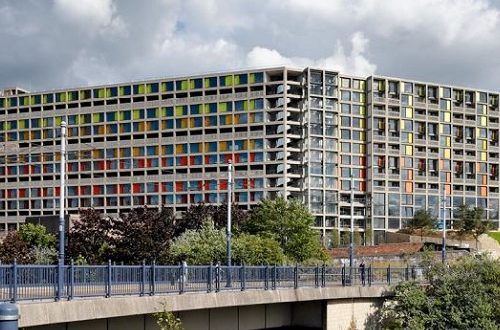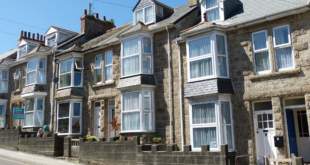In the 1960’s and beyond, many of our cities were remodelled. Many streets, some slums, but others not, were cleared away and replaced in many cases, by flats many of which had shorter useful lives than their predecessors. In more recent years, up and down the country, local authorities and developers are increasingly looking at regeneration rather than demolition. Today, companies such as UrbanSplash are successfully redeveloping former residential as well as former industrial buildings. Here we look at some examples.
Park Hill Flats, Sheffield
The cities skyline by the main railway station is dominated by Park Hill Flats, built on a hill overlooking the city. Built in the late 1950’s on the site of former slums, they covered over 400 acres and provided nearly 1000 flats. Shops and other facilities were provided and unusually, the corridors were wide “streets in the sky” to encourage interaction. There is even film footage of a milkman in his electric milk float delivering to homes “in the sky.”
Like many of it’s contemporaries, after a promising start, Park Hill Flats lost their shine. They fell into disrepair and became an unpopular place to live. If it hadn’t been for Grade 2 listing by English Heritage in 1989, they would have probably been demolished. It is Europe’s largest listed structure.
In 2004 Urbansplash took over the estate from the city council. Since then the process of transforming this unloved area of Sheffield into a desirable place to live began. Click to look at the plans. As well as flats for sale, social and student housing is planned. In line with the original ethos, there are local services, gardens and art facilities.
Manningham Mills, Bradford
The Victorians built things to last, they also liked to show off! None more so than Bradford’s Manningham (or Listers Mill). Once the world’s largest silk spinning mill, it wasn’t only large but impressive to look at as well, not least it’s finely decorated chimney nearly 250 feet tall. Sadly many such mills haven’t survived, some more valuable for their recyclable stone than as a building.
Fortunately, this is not the case here. Manningham Mills, a Grade Two listed building is being regenerated to provide new homes and commercial facilities. The initial phase, the Silk Mill comprised of 130 flats. Phase Two, the Velvet Mill is now underway.
Royal William Yard, Plymouth
Built around 1830 as a victualling facility for the navy. The complex comprises of a number of solidly built buildings built for storage, baking, brewing etc. The site is Grade One Listed and considered one of Europe’s most important military buildings.
Although hidden away from the city near the still very active Devonport Dockyard, it’s now a thriving area for entertainment, eating out and living. Find out more by clicking here.
Rotunda Birmingham
Birmingham’s city centre was largely redeveloped following the second world war. The Rotunda, an unusual cylindrical shaped building formed part of the Bull Ring Shopping and New Street Station redevelopment in the 1960’s. Having fallen out of favour by the 1990’s it faced a similar fate to it’s neighbours.
Saved from demolition, it now comprises of over 230 apartments and arguably, continues to be the most distinctive building on the Birmingham skyline.
 Homeowners Club If you are one of the 15 million homeowners in the UK, the free to join online Homeowners Club is for you.
Homeowners Club If you are one of the 15 million homeowners in the UK, the free to join online Homeowners Club is for you.








